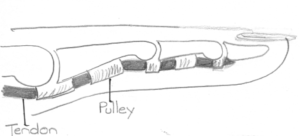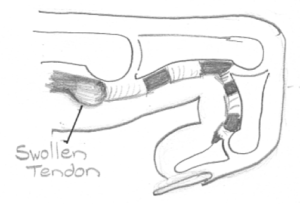Trigger Finger
Muscles attach to bones via their rope-like extensions called tendons. When muscles contract they pull the tendons and hence our joints bend.
For tendons to glide smoothly through tissue they run through lubricated tissue (synovial tissue) In the hands, this tissue is well formed into tunnels which are reinforced with pulleys to make the tunnel extra strong and act to guide the tendons around the curves of the hand and fingers when the joints are placed in different positions.
If there is swelling around the tendon or in the tunnel (so called ‘synovitis’, ‘tenosynovitis’ or ‘stenosing tenosynovitis’) then the tendons gliding is impeded and the tendon movement becomes difficult, jerky (‘triggering’) or jammed.
Sometimes the swelling can be set off following an injury and sometimes by an underlying medical problem eg. Rheumatoid arthritis.
It is also commonly associated with problems like carpal tunnel syndrome and occurs more commonly in people with diabetes.
The exact causal mechanism in most people however is often a mystery and unless an association or cause is clear, or the problem repetitive, a cause is usually not chased.
REST – Initially simple treatment involving anti-inflammatories and resting the finger (sometimes with the help of a splint) will be used. If the problem doesn’t settle quickly over 3-4 weeks then other intervention is usually necessary.
INJECTION – If you have not had the problem before and there is no underlying medical problem precipitating things there is an 80% chance a single steroid injection will settle the problem long term. About 20% of people will have an inadequate outcome or will return with a recurrence.
SURGERY – In those in whom the same finger is a recurrent problem, surgical intervention is usually considered. Surgery involves opening up the tight tunnel at the point it is catching by dividing the restricting pulley, allowing the tendon to glide unimpeded. This can usually be done under a local anaesthetic



